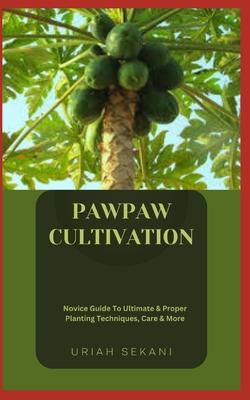
Book
Pawpaw Cultivation: Novice Guide To Ultimate & Proper Planting Techniques, Care & More
by Uriah Sekani
(Write a Review)
Paperback
$8.99
- Pawpaw trees are deciduous and can reach heights of 10-40 feet, with a straight trunk and a pyramidal crown. The dark green foliage alternate with lighter green ones and turn a bright yellow in the fall. The clusters of blooms are a purplish brown color and hang together.
- The tree's star attraction is its delicious pawpaw fruit. The length of this oblong fruit ranges from three to six inches. The fruit is skin turns a soft greenish yellow when it is ready to eat. The meat has a custardy texture and a mild yellow to orange hue. The distinctive flavor has been likened to a cross between banana, mango, and melon. Big, black seeds can be found inside the fruit.
- Pawpaw trees need a soil that is rich, wet, and well-drained to grow. These plants thrive in the dappled shadow of the forest floor. They thrive in mild winters and can withstand freezing temperatures, although late spring frosts can ruin their blossoms and immature fruit. The eastern United States is typical of the kind of climate where pawpaw trees thrive.
- Growing a pawpaw tree from seed can be done, but it could be quite a while before the tree bears fruit. It is also possible to grow new trees from root suckers or via grafting. Fruit production from pawpaw trees requires cross-pollination between various trees because they are not self-pollinating.
- The pawpaw fruit is versatile in the kitchen and can be utilized in many different ways. It has a reputation for having a robust, tropical taste. The fruit is quickly bruised, therefore it is advisable to eat it as soon after picking as possible.
- The pawpaw tree is vital to the habitats in which it thrives. Many insects, birds, and mammals rely on it for sustenance and shelter. Due of its strong, unpleasant odor, flies and beetles are the primary pollinators of these blooms. Both erosion and the loss of forest biodiversity are reduced because to the tree's presence.
Due to its unusual fruit and ecological importance, pawpaw trees have become increasingly popular among enthusiasts and horticulturists. They may not get as much attention or cultivation as other fruit trees, but they are worth seeking out for their unique flavor and the diversity they bring to natural areas.
- Pawpaw trees are deciduous and can reach heights of 10-40 feet, with a straight trunk and a pyramidal crown. The dark green foliage alternate with lighter green ones and turn a bright yellow in the fall. The clusters of blooms are a purplish brown color and hang together.
- The tree's star attraction is its delicious pawpaw fruit. The length of this oblong fruit ranges from three to six inches. The fruit is skin turns a soft greenish yellow when it is ready to eat. The meat has a custardy texture and a mild yellow to orange hue. The distinctive flavor has been likened to a cross between banana, mango, and melon. Big, black seeds can be found inside the fruit.
- Pawpaw trees need a soil that is rich, wet, and well-drained to grow. These plants thrive in the dappled shadow of the forest floor. They thrive in mild winters and can withstand freezing temperatures, although late spring frosts can ruin their blossoms and immature fruit. The eastern United States is typical of the kind of climate where pawpaw trees thrive.
- Growing a pawpaw tree from seed can be done, but it could be quite a while before the tree bears fruit. It is also possible to grow new trees from root suckers or via grafting. Fruit production from pawpaw trees requires cross-pollination between various trees because they are not self-pollinating.
- The pawpaw fruit is versatile in the kitchen and can be utilized in many different ways. It has a reputation for having a robust, tropical taste. The fruit is quickly bruised, therefore it is advisable to eat it as soon after picking as possible.
- The pawpaw tree is vital to the habitats in which it thrives. Many insects, birds, and mammals rely on it for sustenance and shelter. Due of its strong, unpleasant odor, flies and beetles are the primary pollinators of these blooms. Both erosion and the loss of forest biodiversity are reduced because to the tree's presence.
Due to its unusual fruit and ecological importance, pawpaw trees have become increasingly popular among enthusiasts and horticulturists. They may not get as much attention or cultivation as other fruit trees, but they are worth seeking out for their unique flavor and the diversity they bring to natural areas.
Paperback
$8.99